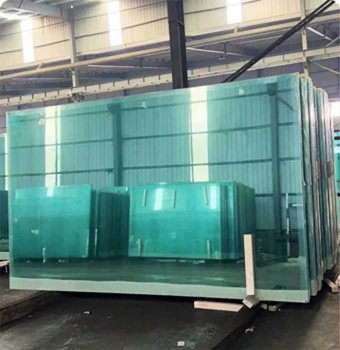Understanding Toughened Glass Sheets
Toughened glass, also known as tempered glass, is a type of safety glass that has been heat-treated to enhance its strength and durability. This process involves heating the glass to a high temperature and then rapidly cooling it, which places the outer layers of the glass in compression and the inner layers in tension. The result is a glass sheet that is several times stronger than ordinary glass, making it a popular choice for various applications in both residential and commercial settings.
One of the most significant advantages of toughened glass sheets is their ability to withstand impact. Unlike standard glass, which can shatter into sharp shards when broken, toughened glass breaks into small, relatively harmless pieces. This characteristic makes it an ideal material for environments where safety is a concern, such as in shower enclosures, glass doors, and windows. In addition, the durability of toughened glass means it can withstand temperature fluctuations and does not easily break under stress.
Toughened glass is widely used in construction and architecture due to its versatility and aesthetic appeal. Architects and designers often choose toughened glass for facades, skylights, and curtain walls because it brings a modern feel to buildings while providing unobstructed views and ample natural light. The transparency and clarity of toughened glass can enhance the beauty of a structure while also offering superior energy efficiency when combined with appropriate insulating technologies.
toughened glass sheet
Another significant application of toughened glass sheets is in the automotive industry. Car windows are often made from toughened glass because of its ability to resist shattering in the event of an accident. This feature not only protects passengers but also improves overall vehicle safety. Furthermore, toughened glass is used in the production of side windows, back windows, and even some sunroofs, ensuring that vehicles are both stylish and secure.
In the furniture industry, toughened glass is used to create elegant and modern designs for tables, shelves, and partitions. The strength of the glass allows designers to create thin profiles without sacrificing durability, resulting in sleek and contemporary pieces that appeal to a wide range of consumers. Additionally, toughened glass surfaces are easy to clean and resistant to scratches, which makes them a practical choice for households and commercial spaces alike.
Despite its numerous advantages, it is essential to consider the potential drawbacks of toughened glass sheets. One major limitation is that once the glass has been tempered, it cannot be cut or resized. This makes pre-measurement crucial before the manufacturing process begins. Additionally, toughened glass can be more expensive than standard glass, which may be a factor for those on a tight budget.
In conclusion, toughened glass sheets offer an array of benefits that make them a valuable material in various industries, including construction, automotive, and furniture design. Their strength, safety features, and aesthetic qualities position them as a preferred choice for architects, designers, and consumers alike. As technology continues to advance, we can expect to see further innovations in toughened glass products, enhancing their application and availability in our daily lives. Whether for a new home project or upgrading an existing space, toughened glass is a material that combines functionality with elegance, providing a perfect solution for those who seek beauty and safety in their environments.
 Afrikaans
Afrikaans  Albanian
Albanian  Amharic
Amharic  Arabic
Arabic  Armenian
Armenian  Azerbaijani
Azerbaijani  Basque
Basque  Belarusian
Belarusian  Bengali
Bengali  Bosnian
Bosnian  Bulgarian
Bulgarian  Catalan
Catalan  Cebuano
Cebuano  Corsican
Corsican  Croatian
Croatian  Czech
Czech  Danish
Danish  Dutch
Dutch  English
English  Esperanto
Esperanto  Estonian
Estonian  Finnish
Finnish  French
French  Frisian
Frisian  Galician
Galician  Georgian
Georgian  German
German  Greek
Greek  Gujarati
Gujarati  Haitian Creole
Haitian Creole  hausa
hausa  hawaiian
hawaiian  Hebrew
Hebrew  Hindi
Hindi  Miao
Miao  Hungarian
Hungarian  Icelandic
Icelandic  igbo
igbo  Indonesian
Indonesian  irish
irish  Italian
Italian  Japanese
Japanese  Javanese
Javanese  Kannada
Kannada  kazakh
kazakh  Khmer
Khmer  Rwandese
Rwandese  Korean
Korean  Kurdish
Kurdish  Kyrgyz
Kyrgyz  Lao
Lao  Latin
Latin  Latvian
Latvian  Lithuanian
Lithuanian  Luxembourgish
Luxembourgish  Macedonian
Macedonian  Malgashi
Malgashi  Malay
Malay  Malayalam
Malayalam  Maltese
Maltese  Maori
Maori  Marathi
Marathi  Mongolian
Mongolian  Myanmar
Myanmar  Nepali
Nepali  Norwegian
Norwegian  Norwegian
Norwegian  Occitan
Occitan  Pashto
Pashto  Persian
Persian  Polish
Polish  Portuguese
Portuguese  Punjabi
Punjabi  Romanian
Romanian  Russian
Russian  Samoan
Samoan  Scottish Gaelic
Scottish Gaelic  Serbian
Serbian  Sesotho
Sesotho  Shona
Shona  Sindhi
Sindhi  Sinhala
Sinhala  Slovak
Slovak  Slovenian
Slovenian  Somali
Somali  Spanish
Spanish  Sundanese
Sundanese  Swahili
Swahili  Swedish
Swedish  Tagalog
Tagalog  Tajik
Tajik  Tamil
Tamil  Tatar
Tatar  Telugu
Telugu  Thai
Thai  Turkish
Turkish  Turkmen
Turkmen  Ukrainian
Ukrainian  Urdu
Urdu  Uighur
Uighur  Uzbek
Uzbek  Vietnamese
Vietnamese  Welsh
Welsh  Bantu
Bantu  Yiddish
Yiddish  Yoruba
Yoruba  Zulu
Zulu 

